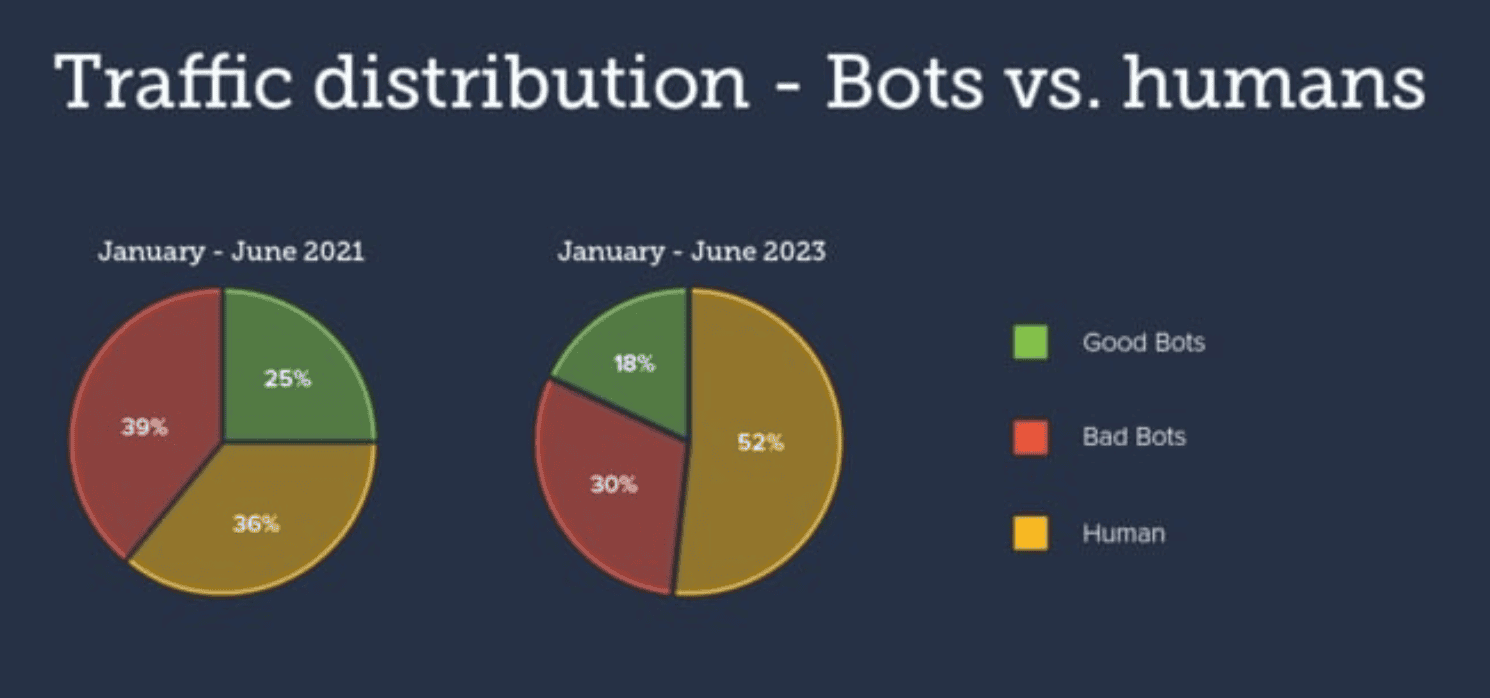According to latest statistics and analysis Bad Bots now account for 73% of all internet traffic. The top five targeted industries are technology (Bad Bots comprise 76% of its internet traffic); gaming (29% of traffic), social media (46%), e-commerce (65%), and financial services (45%)
When these bad bots pretend to be real users, they give the people controlling them the power to do all kinds of nasty stuff. It’s not just hackers; it could be rival companies trying to pull a fast one or shady folks looking to scam others.
The surge in artificial intelligence might be associated with a notable increase in ‘scraping’ bots designed to collect data and images from websites.
In 2023, between Q1 and Q2, scraping activity saw a staggering 432% rise. The scraping of social media accounts poses a significant threat, as it enables the gathering of personal data utilised by generation-AI for the large-scale production of compelling phishing attacks.
Subsequently, other bots could be employed to disseminate account takeover emails, execute romance scams, and target various sectors such as travel and hospitality.
It’s crucial to acknowledge that scraping operates within a legal gray area. While not explicitly illegal, engaging in scraping that violates a website’s terms of use is considered morally questionable.
Some services openly provide web scraping capabilities, illustrating the interconnected relationship between CaaS, AI, and bots, with a particular emphasis on scraping in this context.
What Are Bad Bots?
These malicious bots are automated programs and scripts crafted with harmful intentions to engage in a variety of activities on the internet, frequently resulting in negative consequences for individuals, organisations, and online environments. Their notable threat lies in their capacity to emulate the behaviors of genuine users while interacting with applications.
When posing as legitimate users, these nefarious bots provide a tool for bot operators, attackers, unethical competitors, and fraudsters to carry out a wide array of malicious actions.
According to Arkose Labs the continuing increase in the volume of Bad Bots suggests they remain profitable for the criminals. The arrival of gen-AI will improve the performance of Bad Bots, while the growth of CaaS will increase the number of Bad Bot operators; so, it will get worse.
The only solution is Bad Bot detection and mitigation to limit the access of the bots to their human or system targets. If it is not profitable, they won’t do it.
The top five industries that often face targeted attacks include technology, where 76% of internet traffic comes from Bad Bots, gaming (29% of traffic), social media (46%), e-commerce (65%), and financial services (45%).
Arkose Labs says when bots fail to achieve their goals, there’s a concerning trend of criminals turning to human-operated fraud farms..
There were over 3 billion fraud farm attacks in the first half of 2023. The fraudulent activities seem to be concentrated mainly in Brazil, India, Russia, Vietnam, and the Philippines.
The increasing prevalence of Bad Bots is expected to grow for two main reasons: the emergence and widespread availability of artificial intelligence, particularly gen-AI, and the growing professionalism of the criminal underworld with the introduction of new crime-as-a-service (CaaS) offerings.
The ominous shadow of bad bot traffic looms large as move further into 2024. Despite relentless efforts to fortify online defenses, the relentless surge of these virtual adversaries persists, infiltrating the very fabric of the internet.
Much like a relentless adversary, bad bots have proven their ability to adapt and evolve, making them a formidable challenge for cybersecurity experts and organisations worldwide.
The rise of bad bot traffic serves as a stark reminder that as we forge ahead into the digital frontier, it is the synergy of human intelligence and technological prowess that will ultimately prevail against the forces that threaten our online sanctuaries.
As the cyber battleground continues to evolve, the human element remains our most potent weapon in the quest for a secure and resilient digital future.


